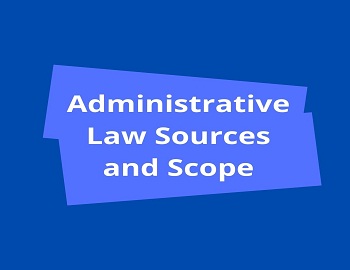Table of Contents
Administrative Law Sources and Scope:
Administrative Law Sources:
Administrative Law comprises a large number of statutes, charters, rules, regulations and procedures as also those resolutions, orders and decisions which are meant for the smooth and systematic running of the administration.
The chief sources of Administrative Law are-
(1) The Constitution of the State.
(2) The enactments or statutes and resolutions of the legislature.
(3) Charters.
(4) Ordinances, rules, regulations, orders or decisions issued by administrative authorities.
(5) Customs and Conventions.
(6) Judicial Decisions of the courts.
Administrative Law, like every other body of law, is the result of both enactment and evolution and hence it has several sources.
Administrative Law Scope:
In the broader sense, Administrative Law covers all the statutes, charters, resolutions, rules, regulations, judicial decisions and orders which have a bearing upon the structure of the administrative authorities, the distribution of functions among them, their powers and procedures, their personnel and finance, and their responsibility. In the narrower sense, Administrative Law is the law of official powers and responsibility or the law which determines the amount of discretion permitted to administrative officers and agencies.
The committee of Public Administrative of the Social Research Council of the USA (1938) gave the following outlines of the scope of Administrative Law-
(1) Problems of public personnel.
(2) Problems of fiscal administration.
(3) Studies in the legal conditions in administrative discretion.
(4) The problem of administrative courts and administrative law.
(5) Law of administrative regulations.
(6) Problems of administrative examinations.
(7) Studies in government contracts.
(8) Claims against the government.
(9) Studies in remedies against administrative action.
(10) Status and recognition of professional associations in public administration.
(11) The legal rules governing the actions of plural headed administrative bodies.
James Hart divides the field of administrative law into the law of internal administration and the law of external administration.
(A) The law of internal administration includes topics such as legal disqualification for officers, the legal aspect of appointments, tenure and conditions of service, legal aspects of the hierarchical form of departmental organisation, the legal relation of the administrative superior to the subordinate and the legal relations between the power of removal and the administrative management.
(B) The law of external administration includes four parts i.e.
(1) Powers and duties of administrative authorities related directly to private interests.
(2) The scope and limits of such powers.
(3) Sanctions attached to official decisions.
(4) The remedies against official action.
Thus the scope of Administrative Law is very vast.









Comments (No)